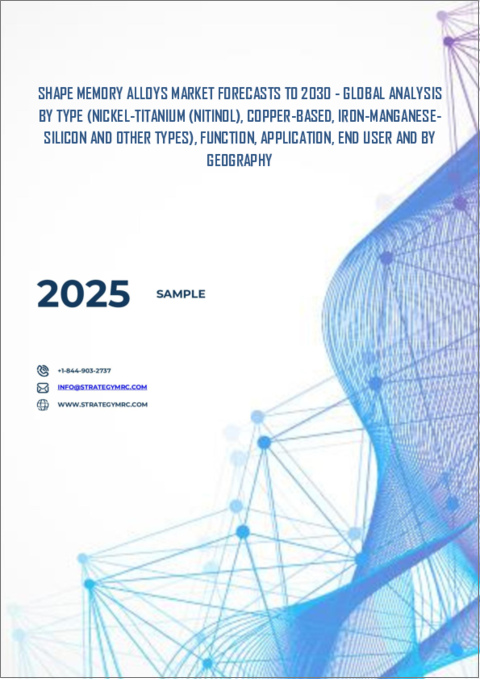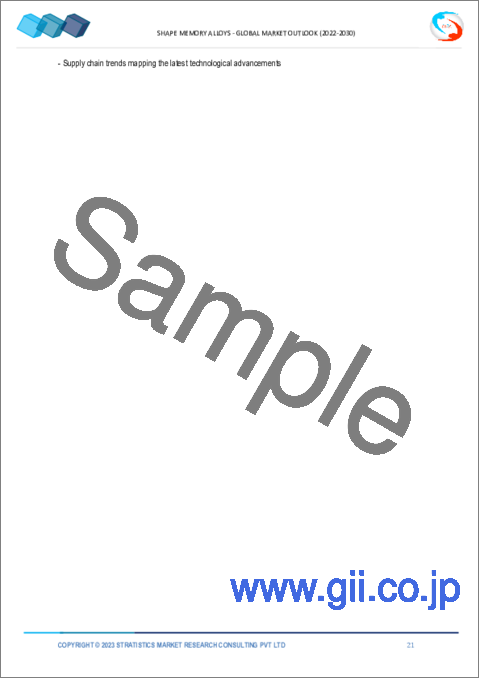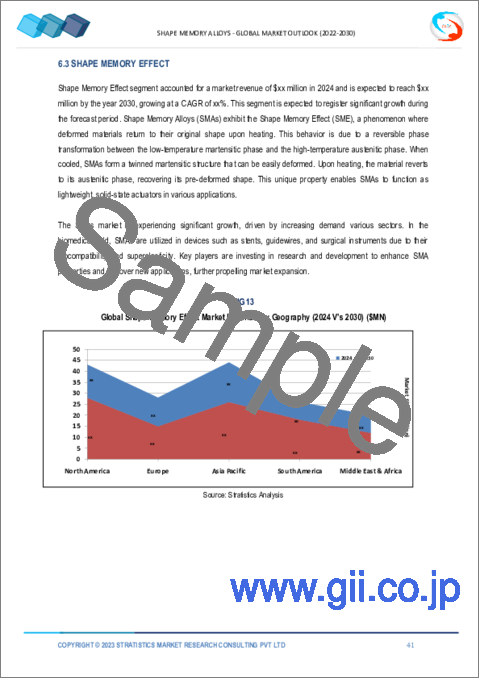|
|
市場調査レポート
商品コード
1530850
形状記憶合金の2030年までの市場予測: タイプ別、機能別、用途別、エンドユーザー別、地域別の世界分析Shape Memory Alloys Market Forecasts to 2030 - Global Analysis By Type (Nickel-Titanium (Nitinol), Copper-based, Iron-Manganese-Silicon and Other Types), Function, Application, End User and By Geography |
||||||
カスタマイズ可能
|
|||||||
| 形状記憶合金の2030年までの市場予測: タイプ別、機能別、用途別、エンドユーザー別、地域別の世界分析 |
|
出版日: 2024年08月01日
発行: Stratistics Market Research Consulting
ページ情報: 英文 200+ Pages
納期: 2~3営業日
|
全表示
- 概要
- 図表
- 目次
Stratistics MRCによると、形状記憶合金の世界市場は2024年に156億米ドルを占め、予測期間中のCAGRは12.5%で成長し、2030年には317億米ドルに達すると予測されています。
形状記憶合金は、特定の温度にさらされると変形後に元の形状に戻ることができる材料です。超弾性や形状記憶効果などのユニークな特性により、主に医療機器、航空宇宙、自動車、家電製品に使用されています。形状記憶合金市場は、技術の進歩、用途の増加、様々な産業における高精度製造ソリューションの需要に牽引され、力強い成長を遂げています。
Journal of Materials Science誌に掲載された調査論文によると、ニッケルチタン(NiTi)SMAは最大8%の形状回復歪みと500MPa以上の回復応力を示します。
医療用途での需要の増加
医療産業が形状記憶合金市場の著しい成長を牽引しています。これらの材料は、生体適合性、超弾性、形状記憶効果などのユニークな特性により、低侵襲手術装置、歯列矯正用ワイヤー、ステント、インプラントなどでますます使用されるようになっています。世界人口の高齢化と医療技術の進歩は、形状記憶合金を利用した革新的な医療機器への需要に拍車をかけています。熱を加えると所定の形状に戻るという特性は、自己拡張型ステントやその他の医療用途に理想的であり、市場拡大の原動力となっています。
材料コストの高さ
形状記憶合金、特にニッケルチタン(ニチノール)の高コストが市場成長の大きな抑制要因となっています。これらの合金の製造に必要な複雑な製造工程、特殊な設備、精密な制御が、製造コストの高さの一因となっています。さらに、ニッケルやチタンのような使用される原材料は高価な場合があります。これらの要因により、形状記憶合金は従来の材料に比べてコストが高くなり、価格に敏感な用途や産業での採用が制限されます。高コストは、特に新興市場において、潜在的なユーザーがこれらの合金を製品に組み込むことを躊躇させる可能性があります。
自動車産業での拡大
自動車産業は形状記憶合金市場の成長にとって大きな機会です。これらの材料は、アクチュエーター、センサー、適応部品など、様々な自動車用途でますます研究されています。形状記憶合金は、従来の機械システムに取って代わる可能性があり、軽量化、燃費改善、性能向上などの利点を提供します。自動車産業が電気自動車や自律走行車へとシフトするにつれ、形状記憶合金のような先端材料への需要が高まることが予想されます。
複雑な製造工程
形状記憶合金に必要な複雑な製造工程は、市場成長の脅威となります。これらの合金は、所望の特性を得るために、組成、熱処理、加工パラメーターを正確に制御する必要があります。真空アーク溶解、誘導溶解、慎重な熱処理のような特殊技術が必要であり、多大な専門知識と投資が必要となります。製造の複雑さは、品質管理の問題、生産時間の増加、コストの上昇につながる可能性があります。この脅威は、高品質の形状記憶合金を製造できるメーカーの数を制限し、潜在的にサプライチェーンのボトルネックを生み出し、市場の拡大を妨げる可能性があります。
COVID-19の影響:
COVID-19のパンデミックは、サプライチェーンの中断と主要な最終用途産業からの需要の減少により、当初は形状記憶合金市場を混乱させました。しかし、医療用途、特にCOVID-19治療に使用されるデバイスが急増したため、市場は回復力を示しました。パンデミックは低侵襲医療処置の採用を加速させ、形状記憶合金ベースのデバイスの需要を押し上げました。長期的な影響としては、ヘルスケア用途への注目の高まりとサプライチェーンの多様化が挙げられます。
ニッケルチタン(ニチノール)セグメントが予測期間中最大になる見込み
ニッケル-チタン(ニチノール)は、他の合金に比べて優れた特性を持つため、形状記憶合金市場を独占すると予想されています。ニチノールは優れた生体適合性、耐食性、幅広い変態温度を持ち、医療用途に理想的です。その超弾性特性と形状記憶効果は他に類を見ないもので、航空宇宙や家電など、ヘルスケア以外のさまざまな産業での利用を後押ししています。低侵襲医療機器への需要の高まりや、自動車やロボット分野での用途拡大が、ニチノールの市場優位性をさらに高めています。
民生用電子機器・家電製品分野が予測期間中に最も高いCAGRが見込まれる
民生用電子機器・家電製品分野は、形状記憶合金市場で急成長を遂げようとしています。これらの材料は、振動減衰、熱管理、小型アクチュエータなど様々な機能を持つため、スマートフォン、ノートパソコン、家電製品でますます使用されるようになっています。形状記憶合金は、よりコンパクトで、効率的で、耐久性のある電子機器の開発を可能にします。スマートホーム技術やウェアラブルデバイスに対する消費者の需要の高まりが、この分野の技術革新を促進しています。さらに、エネルギー効率に優れた動作と機能性向上のために家電製品に形状記憶合金が使用されることが、このセグメントの高い成長率に寄与しています。
最大のシェアを占める地域:
北米地域が形状記憶合金市場を独占すると予想されます。同地域が形状記憶合金市場で優位を占める背景には、先進的なヘルスケア分野、強力な航空宇宙・防衛産業、研究開発への多額の投資があります。特に米国では革新的な医療技術の採用率が高く、形状記憶合金をベースとした医療機器の需要を促進しています。さらに、主要市場プレイヤーの存在、確立された製造インフラ、支持的な規制環境が北米市場のリーダーシップに寄与しています。
CAGRが最も高い地域:
アジア太平洋地域は、急速な工業化、ヘルスケア支出の増加、自動車および家電部門の成長により、形状記憶合金市場において有利な成長率を示すと思われます。中国、日本、韓国のような国々は、先進製造業と新興技術に多額の投資を行っています。この地域は人口が多く、可処分所得が増加しているため、さまざまな産業で革新的な製品に対する需要が高まっています。さらに、先端材料と先端技術を促進する政府の取り組みが形状記憶合金の採用を後押しし、この地域の高い成長率に寄与していると予想されます。
無料のカスタマイズ提供:
本レポートをご購読のお客様には、以下の無料カスタマイズオプションのいずれかをご利用いただけます:
- 企業プロファイル
- 追加市場プレイヤーの包括的プロファイリング(3社まで)
- 主要企業のSWOT分析(3社まで)
- 地域セグメンテーション
- 顧客の関心に応じた主要国の市場推計・予測・CAGR(注:フィージビリティチェックによる)
- 競合ベンチマーキング
- 製品ポートフォリオ、地理的プレゼンス、戦略的提携に基づく主要企業のベンチマーキング
目次
第1章 エグゼクティブサマリー
第2章 序文
- 概要
- ステークホルダー
- 調査範囲
- 調査手法
- データマイニング
- データ分析
- データ検証
- 調査アプローチ
- 調査情報源
- 1次調査情報源
- 2次調査情報源
- 前提条件
第3章 市場動向分析
- 促進要因
- 抑制要因
- 機会
- 脅威
- 用途分析
- エンドユーザー分析
- 新興市場
- COVID-19の影響
第4章 ポーターのファイブフォース分析
- 供給企業の交渉力
- 買い手の交渉力
- 代替品の脅威
- 新規参入業者の脅威
- 競争企業間の敵対関係
第5章 世界の形状記憶合金市場:タイプ別
- ニッケルチタン(ニチノール)
- 銅ベース
- 鉄・マンガン・シリコン
- その他のタイプ
第6章 世界の形状記憶合金市場:機能別
- 超弾性
- 形状記憶効果
- 減衰特性
- その他の機能
第7章 世界の形状記憶合金市場:用途別
- モーターとアクチュエータ
- 構造材料
- センサー
- エネルギーハーベスティング
- 眼科用機器
- 振動吸収ダンパー
- その他の用途
第8章 世界の形状記憶合金市場:エンドユーザー別
- バイオメディカル
- 航空宇宙および防衛
- 自動車
- 産業
- 家電製品
- その他のエンドユーザー
第9章 世界の形状記憶合金市場:地域別
- 北米
- 米国
- カナダ
- メキシコ
- 欧州
- ドイツ
- 英国
- イタリア
- フランス
- スペイン
- その他欧州
- アジア太平洋
- 日本
- 中国
- インド
- オーストラリア
- ニュージーランド
- 韓国
- その他アジア太平洋地域
- 南米
- アルゼンチン
- ブラジル
- チリ
- その他南米
- 中東・アフリカ
- サウジアラビア
- アラブ首長国連邦
- カタール
- 南アフリカ
- その他中東とアフリカ
第10章 主な発展
- 契約、パートナーシップ、コラボレーション、合弁事業
- 買収と合併
- 新製品発売
- 事業拡大
- その他の主要戦略
第11章 企業プロファイリング
- ATI Inc.
- Confluent Medical Technologies
- Dynalloy Inc.
- ENDOSMART GmbH
- Fort Wayne Metals Research Products Corp.
- Furukawa Electric Co., Ltd
- G. Rau GmbH & Co. KG
- Johnson Matthey plc
- Lumenous Device Technologies, Inc.
- Memry Corporation
- Metalwerks PMD Inc.
- Nippon Steel Corporation
- Nitinol Devices & Components, Inc.
- SAES Getters S.p.A
- Seabird Metal Material Co., Ltd
- TiNi Alloy Co.
- Ultimate NiTi Technologies Inc.
- Xi'an Saite Metal Materials Development Co., Ltd
List of Tables
- Table 1 Global Shape Memory Alloys Market Outlook, By Region (2022-2030) ($MN)
- Table 2 Global Shape Memory Alloys Market Outlook, By Type (2022-2030) ($MN)
- Table 3 Global Shape Memory Alloys Market Outlook, By Nickel-Titanium (Nitinol) (2022-2030) ($MN)
- Table 4 Global Shape Memory Alloys Market Outlook, By Copper-based (2022-2030) ($MN)
- Table 5 Global Shape Memory Alloys Market Outlook, By Iron-Manganese-Silicon (2022-2030) ($MN)
- Table 6 Global Shape Memory Alloys Market Outlook, By Other Types (2022-2030) ($MN)
- Table 7 Global Shape Memory Alloys Market Outlook, By Function (2022-2030) ($MN)
- Table 8 Global Shape Memory Alloys Market Outlook, By Superelasticity (2022-2030) ($MN)
- Table 9 Global Shape Memory Alloys Market Outlook, By Shape Memory Effect (2022-2030) ($MN)
- Table 10 Global Shape Memory Alloys Market Outlook, By Damping Properties (2022-2030) ($MN)
- Table 11 Global Shape Memory Alloys Market Outlook, By Other Functions (2022-2030) ($MN)
- Table 12 Global Shape Memory Alloys Market Outlook, By Application (2022-2030) ($MN)
- Table 13 Global Shape Memory Alloys Market Outlook, By Motors & Actuators (2022-2030) ($MN)
- Table 14 Global Shape Memory Alloys Market Outlook, By Structural Materials (2022-2030) ($MN)
- Table 15 Global Shape Memory Alloys Market Outlook, By Sensors (2022-2030) ($MN)
- Table 16 Global Shape Memory Alloys Market Outlook, By Energy Harvesting (2022-2030) ($MN)
- Table 17 Global Shape Memory Alloys Market Outlook, By Ocular Devices (2022-2030) ($MN)
- Table 18 Global Shape Memory Alloys Market Outlook, By Vibration Dampers (2022-2030) ($MN)
- Table 19 Global Shape Memory Alloys Market Outlook, By Other Applications (2022-2030) ($MN)
- Table 20 Global Shape Memory Alloys Market Outlook, By End User (2022-2030) ($MN)
- Table 21 Global Shape Memory Alloys Market Outlook, By Biomedical (2022-2030) ($MN)
- Table 22 Global Shape Memory Alloys Market Outlook, By Aerospace & Defense (2022-2030) ($MN)
- Table 23 Global Shape Memory Alloys Market Outlook, By Automotive (2022-2030) ($MN)
- Table 24 Global Shape Memory Alloys Market Outlook, By Industrial (2022-2030) ($MN)
- Table 25 Global Shape Memory Alloys Market Outlook, By Consumer Electronics & Home Appliances (2022-2030) ($MN)
- Table 26 Global Shape Memory Alloys Market Outlook, By Other End Users (2022-2030) ($MN)
Note: Tables for North America, Europe, APAC, South America, and Middle East & Africa Regions are also represented in the same manner as above.
According to Stratistics MRC, the Global Shape Memory Alloys Market is accounted for $15.6 billion in 2024 and is expected to reach $31.7 billion by 2030, growing at a CAGR of 12.5% during the forecast period. Shape memory alloys are materials that can return to their original shape after deformation when exposed to specific temperatures. They are primarily used in medical devices, aerospace, automotive, and consumer electronics due to their unique properties like super elasticity and the shape memory effect. The Shape Memory Alloys market is experiencing robust growth driven by technological advancements, increasing applications, and demand for high-precision manufacturing solutions across various industries.
According to a research paper published in the Journal of Materials Science, Nickel-Titanium (NiTi) SMAs exhibit a shape recovery strain of up to 8% and a recovery stress of over 500 MPa.
Market Dynamics:
Driver:
Increasing demand in medical applications
The medical industry is driving significant growth in the shape memory alloys market. These materials are increasingly used in minimally invasive surgical devices, orthodontic wires, stents, and implants due to their unique properties like biocompatibility, superelasticity, and shape memory effect. The aging global population and advancements in medical technology are fueling demand for innovative medical devices utilizing shape memory alloys. Their ability to return to a predetermined shape when heated makes them ideal for self-expanding stents and other medical applications, driving market expansion.
Restraint:
High cost of materials
The high cost of shape memory alloys, particularly nickel-titanium (Nitinol), is a significant restraint on market growth. The complex manufacturing processes, specialized equipment, and precise control required to produce these alloys contribute to their high production costs. Additionally, the raw materials used, such as nickel and titanium, can be expensive. These factors make shape memory alloys more costly compared to conventional materials, limiting their adoption in price-sensitive applications and industries. The high costs can deter potential users from incorporating these alloys into their products, especially in emerging markets.
Opportunity:
Expansion in the automotive industry
The automotive industry presents a significant opportunity for shape memory alloys market growth. These materials are increasingly being explored for various automotive applications, including actuators, sensors, and adaptive components. Shape memory alloys can potentially replace traditional mechanical systems, offering benefits like reduced weight, improved fuel efficiency, and enhanced performance. As the automotive sector shifts towards electric and autonomous vehicles, the demand for advanced materials like shape memory alloys is expected to rise.
Threat:
Complex manufacturing processes
The complex manufacturing processes required for shape memory alloys pose a threat to market growth. These alloys demand precise control over composition, heat treatment, and processing parameters to achieve desired properties. Specialized techniques like vacuum arc melting, induction melting, and careful heat treatments are necessary, requiring significant expertise and investment. The complexity of manufacturing can lead to quality control issues, increased production times, and higher costs. This threat may limit the number of manufacturers capable of producing high-quality shape memory alloys, potentially creating supply chain bottlenecks and hindering market expansion.
Covid-19 Impact:
The Covid-19 pandemic initially disrupted the shape memory alloys market due to supply chain interruptions and reduced demand from key end-use industries. However, the market showed resilience as medical applications surged, particularly for devices used in Covid-19 treatment. The pandemic accelerated the adoption of minimally invasive medical procedures, boosting demand for shape memory alloy-based devices. Long-term impacts include increased focus on healthcare applications and supply chain diversification.
The Nickel-Titanium (Nitinol) segment is expected to be the largest during the forecast period
The Nickel-Titanium (Nitinol) is anticipated to dominate the shape memory alloys market due to its superior properties compared to other alloys. Nitinol offers excellent biocompatibility, corrosion resistance, and a wide range of transformation temperatures, making it ideal for medical applications. Its superelastic properties and shape memory effect are unmatched, driving its use in various industries beyond healthcare, including aerospace and consumer electronics. The growing demand for minimally invasive medical devices and the expanding applications in the automotive and robotics sectors further contribute to Nitinol's market dominance.
The consumer electronics & home appliances segment is expected to have the highest CAGR during the forecast period
The consumer electronics & home appliances segment is poised for rapid growth in the shape memory alloys market. These materials are increasingly used in smartphones, laptops, and home appliances for various functions such as vibration damping, thermal management, and miniature actuators. Shape memory alloys enable the development of more compact, efficient, and durable electronic devices. The growing consumer demand for smart home technologies and wearable devices is driving innovation in this sector. Additionally, the use of shape memory alloys in appliances for energy-efficient operation and improved functionality is contributing to the segment's high growth rate.
Region with largest share:
The North American region is expected to dominate the shape memory alloys market. The region's dominance in the shape memory alloys market is driven by its advanced healthcare sector, strong aerospace and defense industries, and significant investments in research and development. The region has a high adoption rate of innovative medical technologies, particularly in the United States, which fuels demand for shape-memory alloy-based medical devices. Additionally, the presence of key market players, well-established manufacturing infrastructure, and supportive regulatory environment contribute to North America's market leadership.
Region with highest CAGR:
The Asia Pacific region is set to witness a lucrative growth rate in the shape memory alloys market due to rapid industrialization, increasing healthcare expenditure, and growing automotive and consumer electronics sectors. Countries like China, Japan, and South Korea are investing heavily in advanced manufacturing and emerging technologies. The region's large and growing population, coupled with rising disposable incomes, is driving demand for innovative products across various industries. Additionally, government initiatives to promote advanced materials and technologies are expected to boost the adoption of shape memory alloys, contributing to the region's high growth rate.
Key players in the market
Some of the key players in Shape Memory Alloys market include ATI Inc., Confluent Medical Technologies, Dynalloy Inc., ENDOSMART GmbH, Fort Wayne Metals Research Products Corp., Furukawa Electric Co., Ltd, G. Rau GmbH & Co. KG, Johnson Matthey plc, Lumenous Device Technologies, Inc., Memry Corporation, Metalwerks PMD Inc., Nippon Steel Corporation, Nitinol Devices & Components, Inc., SAES Getters S.p.A, Seabird Metal Material Co., Ltd, TiNi Alloy Co., Ultimate NiTi Technologies Inc., and Xi'an Saite Metal Materials Development Co., Ltd.
Key Developments:
In January 2024, Scottsdale, AZ- Confluent Medical Technologies (Confluent) announced that it has partnered with ATI to invest more than $50 million over the next several years in ATI's Nitinol melt and materials conversion infrastructure. With this significant investment, which will more than triple ATI's melt capacity for medical Nitinol, Confluent will become ATI's fulfillment partner and provide a suite of value-add services and order-fulfillment for ATI medical Nitinol mill product.
In June 2023, Fort Wayne Metals and NASA's Glenn Research Center in Cleveland are advancing shape memory alloy material technology for innovative rover tires that could be used to support the agency's Artemis exploration efforts on the moon. The two organizations have previously collaborated on highly engineered Nitinol materials for many aerospace applications, including use in prototype spring tires for Mars rovers. The current collaboration between Fort Wayne Metals and NASA Glenn includes studying the anticipated operating conditions on the moon and initial Nitinol materials development for various lunar applications.
Types Covered:
- Nickel-Titanium (Nitinol)
- Copper-based
- Iron-Manganese-Silicon
- Other Types
Functions Covered:
- Superelasticity
- Shape Memory Effect
- Damping Properties
- Other Functions
Applications Covered:
- Motors & Actuators
- Structural Materials
- Sensors
- Energy Harvesting
- Ocular Devices
- Vibration Dampers
- Other Applications
End Users Covered:
- Biomedical
- Aerospace & Defense
- Automotive
- Industrial
- Consumer Electronics & Home Appliances
- Other End Users
Regions Covered:
- North America
- US
- Canada
- Mexico
- Europe
- Germany
- UK
- Italy
- France
- Spain
- Rest of Europe
- Asia Pacific
- Japan
- China
- India
- Australia
- New Zealand
- South Korea
- Rest of Asia Pacific
- South America
- Argentina
- Brazil
- Chile
- Rest of South America
- Middle East & Africa
- Saudi Arabia
- UAE
- Qatar
- South Africa
- Rest of Middle East & Africa
What our report offers:
- Market share assessments for the regional and country-level segments
- Strategic recommendations for the new entrants
- Covers Market data for the years 2022, 2023, 2024, 2026, and 2030
- Market Trends (Drivers, Constraints, Opportunities, Threats, Challenges, Investment Opportunities, and recommendations)
- Strategic recommendations in key business segments based on the market estimations
- Competitive landscaping mapping the key common trends
- Company profiling with detailed strategies, financials, and recent developments
- Supply chain trends mapping the latest technological advancements
Free Customization Offerings:
All the customers of this report will be entitled to receive one of the following free customization options:
- Company Profiling
- Comprehensive profiling of additional market players (up to 3)
- SWOT Analysis of key players (up to 3)
- Regional Segmentation
- Market estimations, Forecasts and CAGR of any prominent country as per the client's interest (Note: Depends on feasibility check)
- Competitive Benchmarking
- Benchmarking of key players based on product portfolio, geographical presence, and strategic alliances
Table of Contents
1 Executive Summary
2 Preface
- 2.1 Abstract
- 2.2 Stake Holders
- 2.3 Research Scope
- 2.4 Research Methodology
- 2.4.1 Data Mining
- 2.4.2 Data Analysis
- 2.4.3 Data Validation
- 2.4.4 Research Approach
- 2.5 Research Sources
- 2.5.1 Primary Research Sources
- 2.5.2 Secondary Research Sources
- 2.5.3 Assumptions
3 Market Trend Analysis
- 3.1 Introduction
- 3.2 Drivers
- 3.3 Restraints
- 3.4 Opportunities
- 3.5 Threats
- 3.6 Application Analysis
- 3.7 End User Analysis
- 3.8 Emerging Markets
- 3.9 Impact of Covid-19
4 Porters Five Force Analysis
- 4.1 Bargaining power of suppliers
- 4.2 Bargaining power of buyers
- 4.3 Threat of substitutes
- 4.4 Threat of new entrants
- 4.5 Competitive rivalry
5 Global Shape Memory Alloys Market, By Type
- 5.1 Introduction
- 5.2 Nickel-Titanium (Nitinol)
- 5.3 Copper-based
- 5.4 Iron-Manganese-Silicon
- 5.5 Other Types
6 Global Shape Memory Alloys Market, By Function
- 6.1 Introduction
- 6.2 Superelasticity
- 6.3 Shape Memory Effect
- 6.4 Damping Properties
- 6.5 Other Functions
7 Global Shape Memory Alloys Market, By Application
- 7.1 Introduction
- 7.2 Motors & Actuators
- 7.3 Structural Materials
- 7.4 Sensors
- 7.5 Energy Harvesting
- 7.6 Ocular Devices
- 7.7 Vibration Dampers
- 7.8 Other Applications
8 Global Shape Memory Alloys Market, By End User
- 8.1 Introduction
- 8.2 Biomedical
- 8.3 Aerospace & Defense
- 8.4 Automotive
- 8.5 Industrial
- 8.6 Consumer Electronics & Home Appliances
- 8.7 Other End Users
9 Global Shape Memory Alloys Market, By Geography
- 9.1 Introduction
- 9.2 North America
- 9.2.1 US
- 9.2.2 Canada
- 9.2.3 Mexico
- 9.3 Europe
- 9.3.1 Germany
- 9.3.2 UK
- 9.3.3 Italy
- 9.3.4 France
- 9.3.5 Spain
- 9.3.6 Rest of Europe
- 9.4 Asia Pacific
- 9.4.1 Japan
- 9.4.2 China
- 9.4.3 India
- 9.4.4 Australia
- 9.4.5 New Zealand
- 9.4.6 South Korea
- 9.4.7 Rest of Asia Pacific
- 9.5 South America
- 9.5.1 Argentina
- 9.5.2 Brazil
- 9.5.3 Chile
- 9.5.4 Rest of South America
- 9.6 Middle East & Africa
- 9.6.1 Saudi Arabia
- 9.6.2 UAE
- 9.6.3 Qatar
- 9.6.4 South Africa
- 9.6.5 Rest of Middle East & Africa
10 Key Developments
- 10.1 Agreements, Partnerships, Collaborations and Joint Ventures
- 10.2 Acquisitions & Mergers
- 10.3 New Product Launch
- 10.4 Expansions
- 10.5 Other Key Strategies
11 Company Profiling
- 11.1 ATI Inc.
- 11.2 Confluent Medical Technologies
- 11.3 Dynalloy Inc.
- 11.4 ENDOSMART GmbH
- 11.5 Fort Wayne Metals Research Products Corp.
- 11.6 Furukawa Electric Co., Ltd
- 11.7 G. Rau GmbH & Co. KG
- 11.8 Johnson Matthey plc
- 11.9 Lumenous Device Technologies, Inc.
- 11.10 Memry Corporation
- 11.11 Metalwerks PMD Inc.
- 11.12 Nippon Steel Corporation
- 11.13 Nitinol Devices & Components, Inc.
- 11.14 SAES Getters S.p.A
- 11.15 Seabird Metal Material Co., Ltd
- 11.16 TiNi Alloy Co.
- 11.17 Ultimate NiTi Technologies Inc.
- 11.18 Xi'an Saite Metal Materials Development Co., Ltd






